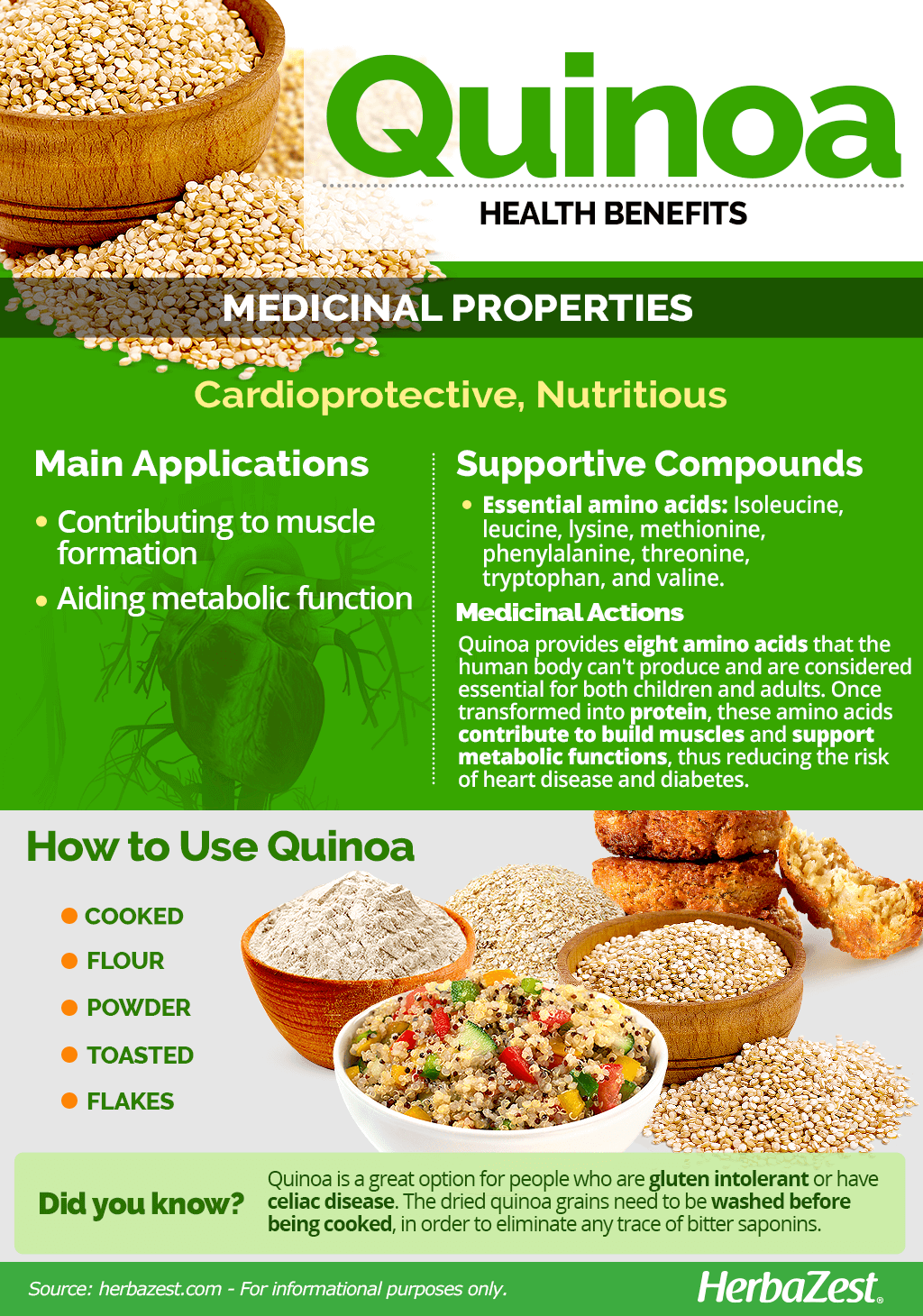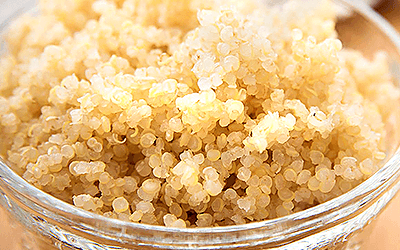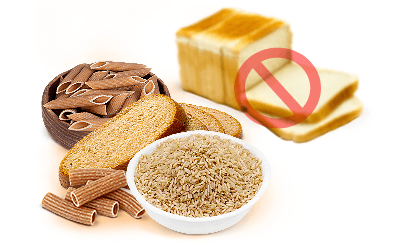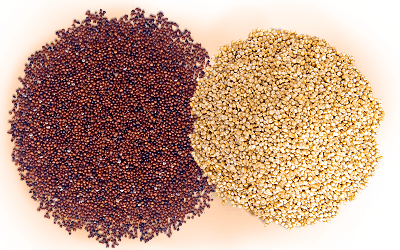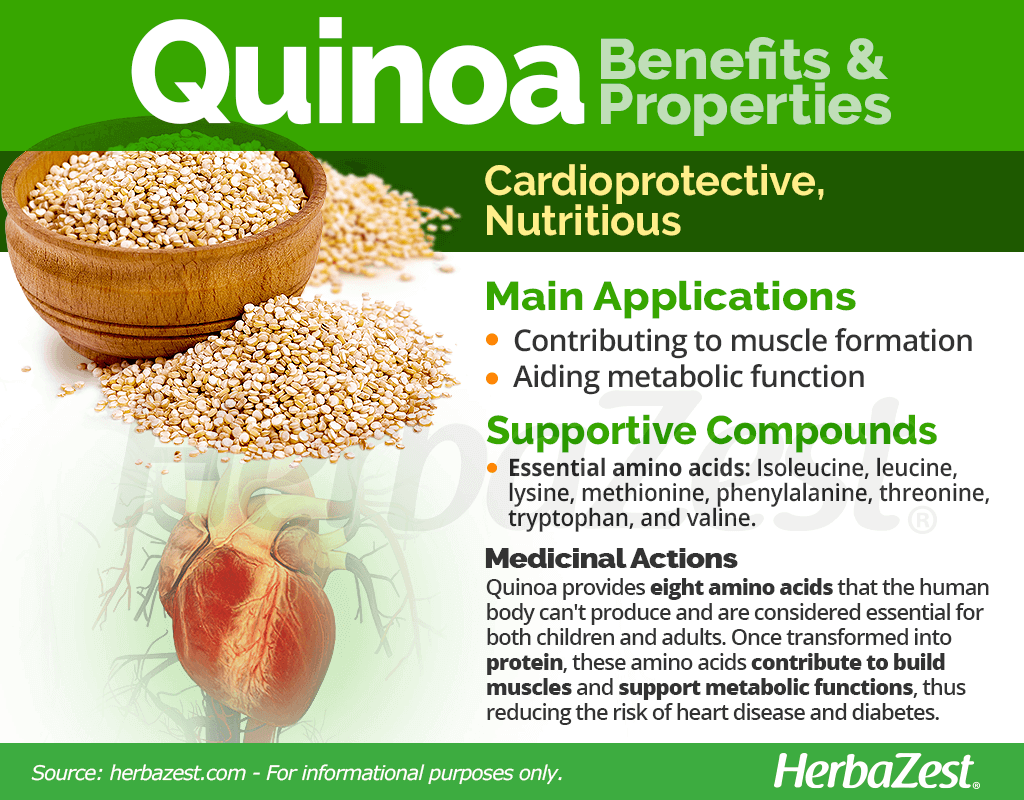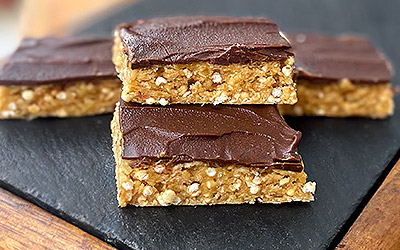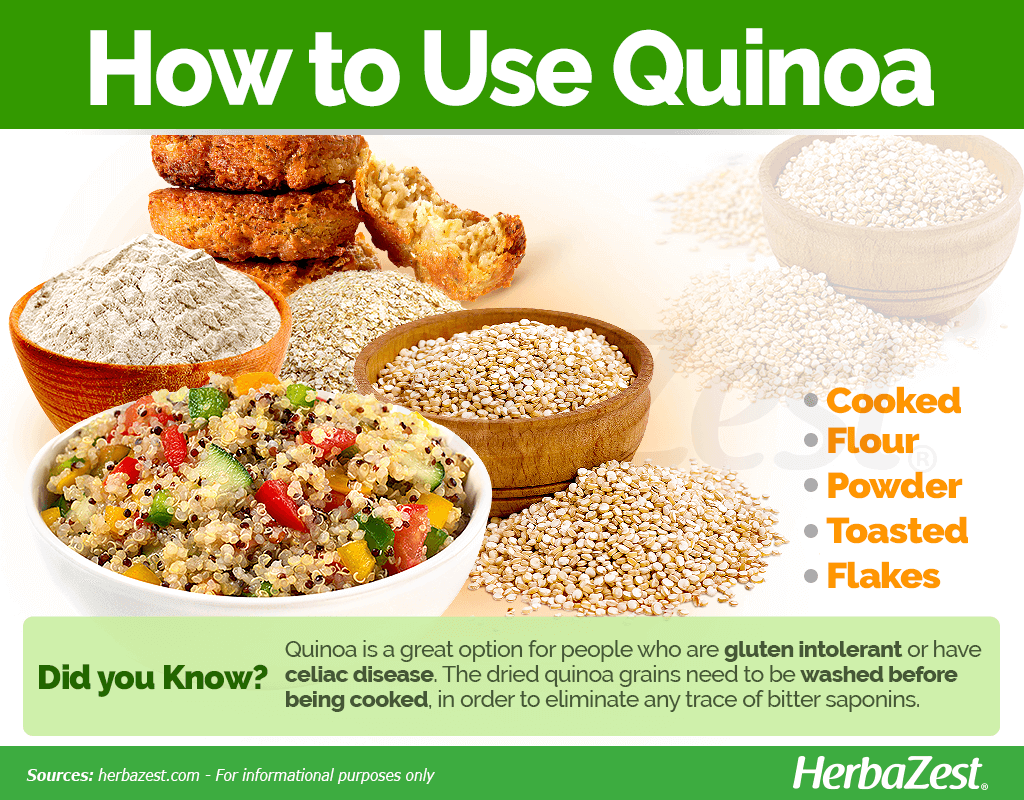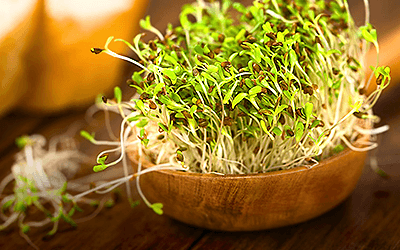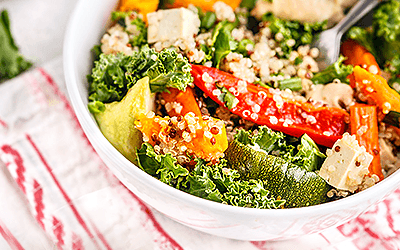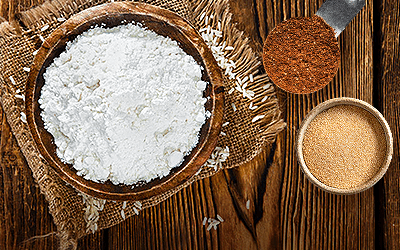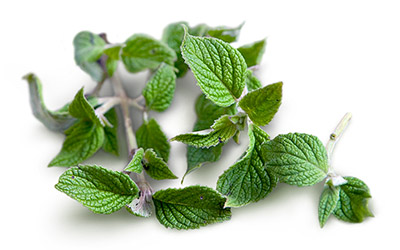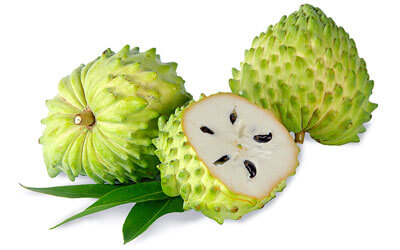Quinoa is one of the oldest crops to have been domesticated in the Andean region of South America and archeological evidence of its importance in the daily diet dates back to approximately 7,000 years ago. In modern times, due to its outstanding nutritional value, the quinoa grain has become so instrumental on the world stage that the United Nations declared 2013 the International Year of Quinoa.
Quinoa Medicinal Properties
Health Benefits of Quinoa
The quinoa grain is rich in essential nutrients when compared to whole grains, particularly protein, as well as in soluble fiber, and it is considered a "medicinal food" with several health benefits, mainly:
Contributing to muscle formation. Quinoa contains all essential amino acids necessary for building muscle, especially in vegetarians and vegans. Since it is free of gluten free, quinoa can be safely eaten by those with celiac disease or gluten intolerance.1
- Decreasing chronic disease risks. A study has shown that eating quinoa can decrease cholesterol levels, thus lowering the risk of developing cardiovascular disease.2 Obese adults can also benefit from quinoa's effects on lowering the prevalence of metabolic syndrome.3
Aiding metabolic function. This Andean superfood offers more than just complete nutrition. It also helps decrease cholesterol, blood pressure, and blood sugar, thus reducing the risk of heart disease and diabetes.
Additionally, the dietary fiber in quinoa can help stool formation and encourage bowel movements, hence relieving constipation. Quinoa is also naturally low in sodium, which makes it a fit choice for everyone, especially those with high blood pressure and other diseases where excessive sodium intake is a concern.
How It Works
Most quinoa properties are determined by a high amount of essential amino acids, which are transformed into bioavailable protein. Quinoa possesses nine amino acids that the human body can't produce. They are considered essential for both children and adults, not only to be transformed into protein and muscle, but also for aiding in many other metabolic functions.
These amino acids include histidine, which is required for protein metabolism and calcium absorption, particularly for optimal development during the first years of life; isoleucine, a blood glucose-lowering amino acid; leucine, which is crucial for building and maintaining muscle mass; lysine and methionine, both required for growth and tissue repair; phenylalanine, which plays a key role in the biosynthesis of other amino acids; threonine, an immunostimulant that promotes endocrine health; tryptophan, which is required for infant growth and brain serotonin synthesis; and valine, which promotes mental vigor, muscle coordination, and emotional calmness.
Hypoglycemic and nutritious properties are also present in beans and sacha inchi.
Quinoa Side Effects
Quinoa is a safe food that rarely provokes allergies or gastrointestinal comfort. Because quinoa grains or seeds contain a large amount of saponin and phytic acid, however, it is important to rinse them thoroughly and cook them before consumption in order to avoid the mildly irritating effects and nutrient absorption problems of these compounds.
COOKING QUINOA (INSTEAD OF SOAKING OR GERMINATING IT) IS RECOMMENDED IN ORDER TO FULLY TAKE ADVANTAGE OF ITS NUTRITIONAL CONTENT.
- Medicinal action Cardioprotective, Nutritious
- Key constituents Essential amino acids: Isoleucine, leucine, lysine, methionine, phenylalanine, threonine, tryptophan, and valine
- Ways to use Food, Powder
- Medicinal rating (4) Very useful plant
- Safety ranking Safe
Quinoa Nutrition
Although the quinoa grain is really a seed, it is widely considered as a pseudo-cereal, mainly due to its botanical profile, as well as for its culinary uses and high levels of nutrients.
Quinoa is a great source of essential amino acids, which are transformed into protein and help building muscle mass. It is also rich in dietary fiber, necessary for glucose metabolism and a smooth digestion, and contains adequate levels of healthy fats, both monounsaturated and polyunsaturated, which help reduce the risk of high cholesterol and heart disease.
Quinoa is a powerhouse of minerals, including manganese, copper, magnesium, phosphorus, iron, and zinc, all of which are necessary for cellular metabolism, as well as for healthy bones and the well-functioning of nerves and muscles. It also provides adequate levels of potassium and selenium, both important for the nervous and immune systems.
This Andean grain is a good source of B complex vitamins, mainly B1 (thiamin), B2 (riboflavin), and B9 (folate), and its nutritional value is rounded by adequate amounts of B3 (niacin) and B6 (pyridoxine), as well as choline and vitamin E (alpha-tocopherol).
A cup of cooked quinoa (185 g) provides 222 calories, as well as 16%, 13%, and 21% of the dietary value for protein, carbohydrates, and dietary fiber, respectively.
Quinoa makes part of an exclusive list of highly nutritious and medicinal crops from South America, including amaranth, kaniwa, maca, mashua, and sacha inchi.
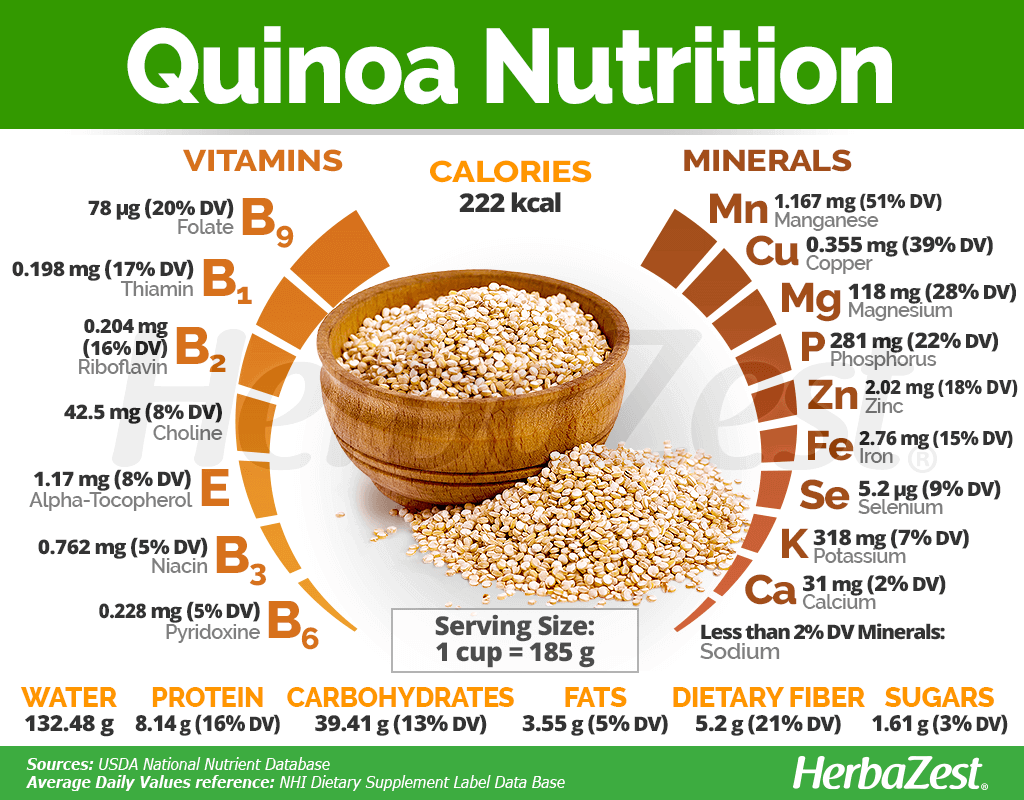
How to Consume Quinoa
Quinoa can be found as a food in a variety of forms, such as quinoa flour, quinoa powder, toasted quinoa, quinoa flakes, and as whole, raw quinoa.
Natural Forms
Cooked. Previously dried and washed to eliminate the saponins that give the grains a slightly bitter taste, it is recommended to cook quinoa very well in order to completely eliminate any trace of phytic acid, tannins, and protease inhibitors, all of which interfere with the absorption of nutrients.
Flour. In the same way as whole grains, quinoa flour needs to be cooked, and it is often used to enrich the nutritional content of wheat flour in baked goods, such as bread and cakes. Quinoa flour is also preferred by people who are gluten intolerant or have celiac disease. It is often mixed with other gluten-free flours, such as barley and rice.
Powder. This form of consumption is a very practical one since it allows for a direct intake without the need for cooking quinoa before consumption. Quinoa powder can be safely mixed into smoothies and shakes as a supplement in order to add an extra punch of nutrition to a healthy diet.
Toasted. When previously toasted, the Andean grain preserves all its nutritional properties and none of the toxins that make it unpalatable in its raw form. It is a great option to add a nutty flavor to salads and smoothies while also as a topping for savory or sweet dishes.
Flakes. In the same fashion as rolled oats, quinoa flakes can be prepared in morning porridge, added to salads and desserts, or mixed with beverages. This form still provides the same nutritional benefits as the previous ones.
- Edible parts Leaves, Seed
- Edible uses Protein
- Taste Earthy
Growing
The quinoa plant (Chenopodium quinoa) is mainly cultivated in the Andean regions of Peru and Bolivia, about 13,123 feet (4000 m) above sea level. However, different varieties have been adapted to grow in other environments, from deserts to high mountain areas.
Additionally, quinoa has also adapted to a wide range of climate conditions, such as warm and dry; temperate and rainy; or temperate with high relative humidity.
More detailed information about growing quinoa can be found in the herb garden section.
- Life cycle Annual
- Harvested parts Seeds
- Light requirements Full sun
- Soil Loamy sand
- Soil pH 6.6 – 7.3 (Neutral)
- Growing habitat Mountain regions, Subtropical regions
- Planting time Spring
- Potential insect pests Earthworms
- Potential diseases Mildew
Additional Information
Plant Biology
Native to Andean region of Bolivia, Ecuador, and Peru, in South America, the quinoa plant grow up to 3.3 - 6.6 feet (1 - 2 m) tall, and flowers range in color from yellow to violet and every shade in between. Their tiny grains (which are really the seeds of the plant) measure approximately 0.08 inches (2 mm) in diameter and have a light-colored ring around their circumferences.
Classification
The quinoa plant, or Chenopodium quinoa, is a member of the Amaranthaceae family, which contains 2,500 species spread out over 180 genera. This family includes many flowering plants, and though it is a widespread family, most of its members are found in tropical areas. It contains other well-known and economically-important herbs, such as amaranth (Amaranthus caudatus), spinach (Spinacia oleracea), and beetroot (Beta vulgaris).
Varieties and Cultivars of Quinoa
Over the course of history, dozens of different varieties of quinoa have developed across the Andean region. However, during the centuries in which the crop suffered from heavy discrimination and low economic value, many of these varieties were lost or became endangered. In modern times, scientists have gone to great lengths to find and preserve these threatened varieties. Yet, the three varieties most commonly cultivated and sold around the world remain black, red, and white quinoa. Of these three, white quinoa is the most common kind.
Historical Information
There are also archeological traces of quinoa being used up to 7,000 years ago, though it was most likely only gathered in the wild during this time. In the Inca culture quinoa was considered a sacred crop, to the point that it was referred to as chisaya mama, which literally means "mother of all grains."
The quinoa plant was discovered by Europeans during the Spanish conquest, but its religious significance appeared threatening to colonial authorities, leading to a suppression of the crop. However, during the second half of the 20th century, the crop was rediscovered by North American and European markets, and from there, its importance spread throughout the world.
Economic Data
Bolivia is currently the top producer of quinoa, responsible for 65% of the world's annual production. The second largest producer is Peru, followed by Ecuador. The popularity of quinoa grain is rising throughout the world, with demand tripling between the years 2006 and 2012. The average crop value of quinoa in 2011 was $ 3,115 USD per ton, and 80,000 metric tons were produced by Bolivia, Peru, and Ecuador that year. Thanks to 2013 being declared International Year of Quinoa, the grain's worldwide exposure has greatly increased, the demand and price also rising accordingly.
Other Uses
Insect repellent. The bitter saponins in quinoa can act as a bug deterrent, and some varieties are kept as ornamental herbs.
Personal care. Due to its high saponin content, the quinoa grain have been used recently to manufacture natural cosmetics, shampoos, and soaps.
Fodder. The leaves of the quinoa plant are sometimes used to feed livestock.
- Other uses Animal feed, Repellent, Soapmaking
Sources
- Food Chemistry, Characterisation of phenolics, betanins and antioxidant activities in seeds of three quinoa genotypes, 2015 | Characterisation of fatty acid, carotenoid, tocopherol compositions and antioxidant activities in seeds of three quinoa genotypes, 2015
- International Journal of Tryptophan Research, L-Tryptophan: Basic Metabolic Functions, Behavioral Research and Therapeutic Indications, 2009
- Plant Foods for Human Nutrition, Effect of quinoa seeds (Chenopodium quinoa) in diet on some biochemical parameters and essential elements in blood of high fructose-fed rats, 2010
- Pseudocereals and Less Common Cereals, pp. 93-94
- PubChem, L-valine | L-phenylalanine| L-threonine
- Quinoa: Improvement and Sustainable Production, p. 26
- Sports Medicine, Leucine supplementation and intensive training, 1999
- The Journal of Nutrition, L-Tryptophan: Basic Metabolic Functions, Behavioral Research and Therapeutic Indications, 2005
- USDA Plants Database, Quinoa: A Plant with a Lot of Potential
- FAOSTAT, Quinoa
- Advances in Food and Nutrition Research, Quinoa (Chenopodium quinoa Willd.): composition, chemistry, nutritional, and functional properties, 2009
- Alternative Field Crops Manual, Quinoa
- American Journal of Gastroenterology, Gastrointestinal effects of eating quinoa (Chenopodium quinoa Willd.) in celiac patients, 2014
Footnotes:
- European Journal of Nutrition. (2020). Modest improvement in CVD risk markers in older adults following quinoa (Chenopodium quinoa Willd.) consumption: a randomized-controlled crossover study with a novel food product. Retrieved May 11, 2021 from https://pubmed.ncbi.nlm.nih.gov/31919583/
- Current Developments in Nutrition. (2017). Quinoa Seed Lowers Serum Triglycerides in Overweight and Obese Subjects: A Dose-Response Randomized Clinical Trial. Retrieved May 11, 2021 from https://academic.oup.com/cdn/article/1/9/e001321/4735236?login=true
- The American Journal of Gastroenterology. (2014). Gastrointestinal effects of eating quinoa (Chenopodium quinoa Willd.) in celiac patients. Retrieved May 11, 2021 from https://pubmed.ncbi.nlm.nih.gov/24445568/
